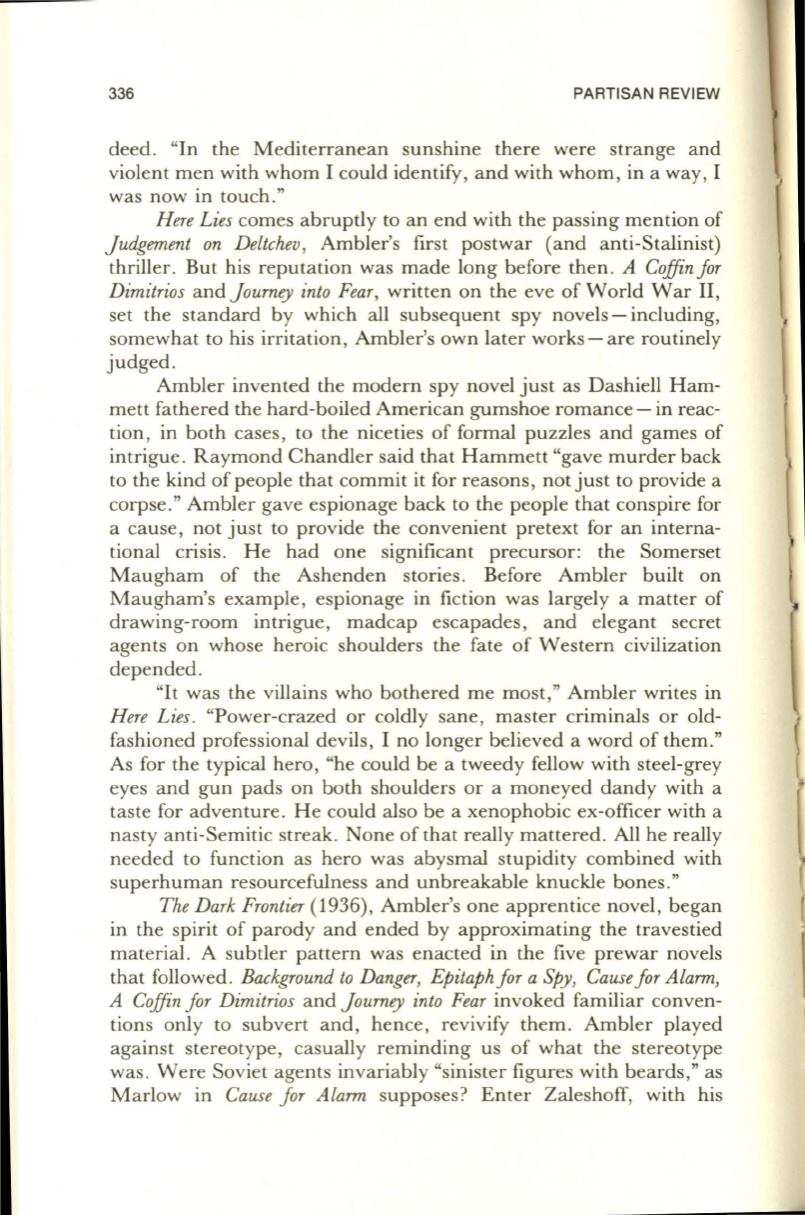
336
PARTISAN REVIEW
deed. "In the Mediterranean sunshine there were strange and
violent men with whom I could identify, and with whom, in a way, I
was now in touch."
Here Lies
comes abruptly to an end with the passing mention of
Judgement on Deltchev ,
Ambler's first postwar (and anti-Stalinist)
thriller. But his reputation was made long before then.
A Coffin Jor
Dimitrios
and
Journey into Fear,
written on the eve of World War II,
set the standard by which all subsequent spy novels - including,
somewhat to his irritation, Ambler's own later works - are routinely
judged .
Ambler invented the modern spy novel just as Dashiell Ham–
mett fathered the hard-boiled American gumshoe romance - in reac–
tion , in both cases, to the niceties of formal puzzles and games of
intrigue. Raymond Chandler said that Hammett "gave murder back
to the kind of people that commit it for reasons, not just to provide a
corpse." Ambler gave espionage back to the people that conspire for
a cause, not just to provide the convenient pretext for an interna–
tional crisis. He had one significant precursor: the Somerset
Maugham of the Ashenden stories. Before Ambler built on
Maugham's example, espionage in fiction was largely a matter of
drawing-room intrigue, madcap escapades, and elegant secret
agents on whose heroic shoulders the fate of Western civilization
depended .
"It
was the villains who bothered me most," Ambler writes in
H ere Lies.
"Power-crazed or coldly sane, master criminals or old–
fashioned professional devils, I no longer believed a word of them."
As for the typical hero, "he could be a tweedy fellow with steel-grey
eyes and gun pads on both shoulders or a moneyed dandy with a
taste for adventure. He could also be a xenophobic ex-officer with a
nasty anti-Semitic streak . None of that really mattered. All he really
needed to function as hero was abysmal stupidity combined with
superhuman resourcefulness and unbreakable knuckle bones ."
The Dark Frontier
(1936), Ambler's one apprentice novel, began
in the spirit of parody and ended by approximating the travestied
material. A subtler pattern was enacted in the five prewar novels
that followed.
Background to Danger, EpitaphJor a Spy, CauseJor Alarm,
A Coffin Jor Dimitrios
and
Journey into Fear
invoked familiar conven–
tions only to subvert and, hence, revivify them . Ambler played
against stereotype, casually reminding us of what the stereotype
was. Were Soviet agents invariably "sinister figures with beards," as
Marlow in
Cause Jor Alarm
supposes? Enter Zaleshoff, with his


